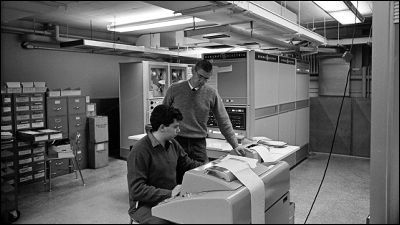A mysterious female secretary contributed to the development of one of the earliest chatbots, ELIZA.

The chatbot 'ELIZA' developed in 1966 is known as one of the earliest chatbots. According to Rebecca Roach , a researcher in media and literary history at the University of Birmingham, an unidentified female secretary played a major role in the research and development of ELIZA.
My search for the mysterious missing secretary who shaped chatbot history
https://theconversation.com/my-search-for-the-mysterious-missing-secretary-who-shaped-chatbot-history-225602
ELIZA is a chatbot developed by Professor Joseph Weizenbaum of the Massachusetts Institute of Technology (MIT). ELIZA can analyze sentences entered by humans and output human-like replies using pre-set templates. ELIZA runs on a very simple program compared to modern chatbots such as ChatGPT, and often outputs a safe reply such as 'Please tell me more.' However, in the 'Turing test,' in which human subjects are asked to determine whether the interlocutor is a human or a chatbot, it outperforms GPT-3.5 and boasts high performance in terms of 'outputting human-like replies.'
1960s chatbot 'ELIZA' beats OpenAI's 'GPT-3.5' in Turing test - GIGAZINE

It is known that ELIZA creates a psychological effect in which people who talk to ELIZA perceive ELIZA as having human-like thinking. This psychological effect is sometimes referred to as the 'ELIZA effect' in modern chatbot research.
Professor Weizenbaum was concerned about the ELIZA effect from the early stages of its development. In the literature he wrote about ELIZA, he detailed the reactions of female secretaries when they used it. For example, a 1967 document contains the following passage:
My secretary watched me work on this program over a long period of time. One day she asked to be permitted to talk with the system. Of course, she knew she was talking to a machine. Yet, after I watched her type in a few sentences she turned to me and said: 'Would you mind leaving the room, please?'
English: My secretary had been watching me work on this program (ELIZA) for a long time. One day, she asked to be allowed to talk to ELIZA. Of course, she knew she was talking to a machine. But as I was watching her type, she turned around and said, 'Would you please leave the room?'
In a book published in 1976, Professor Weizenbaum stated that, based on the female secretary's reaction, 'I never imagined that a short exposure to a relatively simple computer program would induce powerful delusions in an ordinary person.' From the description left by Professor Weizenbaum, Roach believed that 'the reaction of the female secretary had a major impact on ELIZA's research,' and searched the MIT archives to find out the true identity of the female secretary. However, there are no records of the female secretary's true identity, and inquiries to MIT's human resources department and alumni association were unsuccessful. Roach introduces the 'mysterious female secretary who influenced ELIZA's research' as an example of 'people who contributed to the development of computers but did not leave their mark on history.'
As an example of 'people who contributed to the development of computers but did not leave their names in history,' there is the famous case of 'when Bunji Okazaki of Fuji Photo Film Co., Ltd. developed Japan's first domestically produced computer, FUJIC , one female computer made a significant contribution, but the computer's name is not recorded.'
Women called computers
http://www.infonet.co.jp/ueyama/ip/episode/computer.html

Related Posts:
in Software, Posted by log1o_hf






